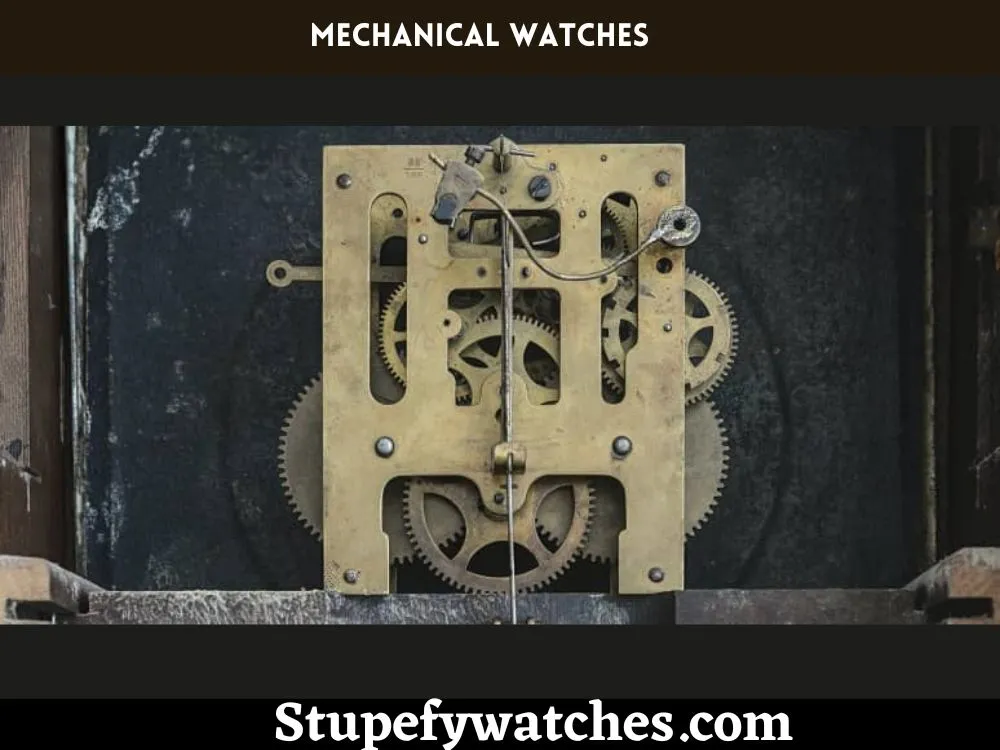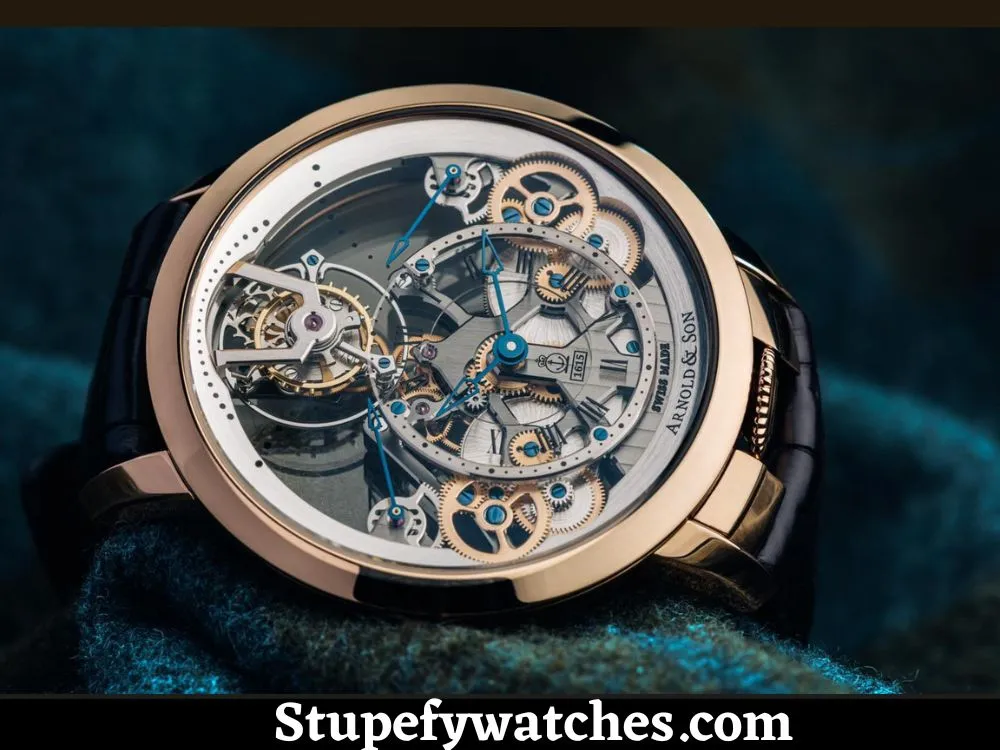What are Mechanical Watches? Just like many others you are also probably looking to know about mechanical watches, their history, and their way of working.
Since their invention back in the 14th century, mechanical watches have evolved a lot, reducing their size until they can be worn on the wrist.
A mechanical watch can be defined as one that works thanks to a mechanical system of springs and gears, without depending on batteries or any other electronic device. Therefore, both automatic and wind-up watches fall into this group.
Today mechanical watches are considered authentic works of art, a precision instrument whose operation is a spectacle of moving parts for those who know how to appreciate it.
If you want to know more details about the history and operation of this micro-engineering masterpiece, we are going to discuss Mechanical Watches, their working style, and their history in this post.
Page Contents
✚ Mechanical watches and their history
Inspired by the intricate Chinese water clocks and Arabic clockwork, the first mechanical clocks appeared in Europe during the second half of the 14th century. In those days they were great machines that occupied a prominent place in some of the tallest towers in Italy and Great Britain.

These were simple watches that used large gears driven by weights and regulated by Foliot-type mechanisms that at best deviated half an hour a day.
Despite being imprecise and breaking easily, these mechanisms were quite an advance at the time and in fact, for more than 300 years it would be the predominant system, although with some updates.
➤ From the weights to the spring
Changes like those introduced by Peter Henlein, a German locksmith from Nuremberg who swapped out the weights for winding springs sometime between 1504 and 1508.
This considerably reduced the size of the mechanisms and allowed the appearance of the first portable mechanical watches.
Designs that soon became very popular among the richest since they could be hung on the wall, on a table, or even worn around the neck.
Although these clocks were egg-shaped, they only had hour hands and no crystal, a feature that would not come onto the scene until the 17th century.
➤ The invention of the pendulum
In 1656, the Dutch scientist Christiaan Huygens invented the first clock regulated by an oscillating pendulum mechanism, although the idea is also attributed to Galileo Galilei, who had already studied the pendulum movement in 1582.

Although Galileo’s designs for a pendulum clock never came to fruition, at least while he was alive.
Huygens continued to refine his automatic watches and over the next few years managed to achieve a precision of fewer than 10 seconds per day.
In fact, his 1675 balance wheel spring design can still be seen on some wristwatches today.
Huygens’ clock was the starting point for a race for precision that led to numerous advances, leading pendulum clocks to dominate timekeeping standards until the invention of the quartz clock in 1927.
➤ The mechanical pocket watch
In parallel, Heinlein’s portable watches continued to evolve and in 1550, thanks to the use of screws, they were able to take the flat shape of the current pocket watch.
Although it would not be until the year 1675 that these mechanical devices would be small enough to be carried in a pocket and not as a pendant.
It is believed that Charles II of Spain himself was the one who popularized this new way of transporting watches in Europe and North America.
It is at this time that the first designs with glass protection appear and soon become luxury items, receiving great attention from designers and fashion experts.

Although all these watches had a big problem, their lack of precision, was something that the English watchmaker Thomas Mudge solved in 1755 by inventing the lever escapement.
Thanks to this ingenuity, the mechanisms went from deviating several hours a day to just one or two minutes, which was a revolution in the watchmaking industry.
Therefore, it is not surprising that after 1820 lever escapement was already present in most mechanical watches around the world, and in fact, it is still used today.
In 1857, the first mass-produced pocket watches with standardized parts appeared, driven by the industrial revolution, allowing everyone to have access to cheap and reliable watches.
The first designs used a key-winding system to wind the mechanism, but in 1860 the crown began to be used to power the watch.
After the outbreak of World War II in 1914, wristwatches became fashionable and pocket designs became history.
Read Our Guide On Mechanical vs Automatic vs Quartz Watches: Which Type of Watch is Best for You?
➤ Mechanical wristwatches
Many claims that the first wristwatch was designed by Abraham-Louis Breguet in 1810 as a gift to Caroline Murat (Queen of Naples), although there is also evidence of an arm watch, a gift from Robert Dudley to Queen Elizabeth I in 1571.
Regardless of which was the first, the truth is that before the First World War, they were only considered jewel-type bracelets for women.

But the pocket watch was not made for the battlefield and the war highlighted the need for soldiers to carry a more practical instrument for combat.
In fact, the first bracelet designs were nothing more than pocket watches modified with a leather strap so that they could be attached to the wrist.
Soon after, numerous manufacturers such as Louis Cartier and Wilsdorf & Davis (later Rolex) began making wristwatches designed especially for the wrist.
In this way, what began as a passing fad for men ended up becoming a revolution in the world of watchmaking, so much so that by 1930 wristwatches already outnumbered pocket watches 50 to 1.
➤ From mechanical to automatic
In 1770 the Swiss watchmaker Abraham-Louis Perrelet devised a system of oscillating counterweights that allowed the watch to be wound automatically while its wearer walked.
In fact, it was advertised as being effective enough to power the mechanism for 8 days with just a 15-minute walk.
For this reason, Perrelet has always been considered the father of the automatic watch, although for historians there is no record of what type of movement he created and they also point to the watchmaker Hubert Sarton, whose sketches and descriptions of the automatic mechanism date from 1778.
Although the automatic design would not succeed until after World War I when industrialization allowed small automatic wristwatches to be made.

The first watchmaker to produce watches of this type was John Harwood whose Swiss-made automatic designs had the capacity to store up to 12 hours of power.
Designs that would soon be adopted and improved by legendary companies such as Rolex, with a system of weights that could move more freely and accumulate up to 35 hours of energy, or Eterna with the introduction of bearings to maintain the structural integrity of the mechanism against shocks, or any other type of external force.
Currently, most of the mechanical wristwatches that are manufactured use automatic mechanisms, and only a few, mainly for collectors, continue to use manual winding.
✚ How does a mechanical watch work?
The mechanical watch works thanks to several moving parts that interact in an orderly way inside to move the hands without the need for batteries or electronic components.
This mechanism known as movement or caliber works thanks to 5 components, present in all mechanical watches:
- Mainspring: It is the part where the mechanical energy that makes the mechanism work is accumulated. Generally a flat spring with a spiral shape.
- Balance or balance wheel: it is the part that is in charge of timing. A weighted wheel that sways at a constant pace, thus marking the passage of time.
- Gear train: It is responsible for transmitting the movement from the main spring to the balance wheel and also for adding each of its oscillations to convert them into hours, minutes and seconds.
- Keyless work: A set of gears separated from the rest that allow the mainspring to be wound by turning the crown. They are also used to set the clock.
- Escapement mechanism: Its function is to make the gears escape or advance a certain number of times with each balance wheel swing. These stops are what produce the characteristic tick-tock of mechanical watches.
By turning the crown of the watch, the keyless work winds the mainspring, charging it with mechanical energy, which in turn is transferred by the gear train to the balance wheel.
The balance wheel swings at a constant rate and each time it does so it unlocks the lever of the escapement mechanism, which releases a tooth from its gear and causes the hands of the clock to always move at the same speed and in the correct direction.
Additionally, when the escapement gear rotates it again pushes the lever, which in turn strikes the balance wheel and propels it back into motion.
In the case of automatic mechanical watches, a system of rotating weights automatically winds the mainspring with each movement of the wrist.
Obviously, this is a simple description of the operation of a mechanical watch that, in addition to telling the time, can have many other functions called complications, such as a calendar, an alarm, or a chronograph, among many others that have been added over centuries of evolution.
✚ The best quality/price mechanical watches
In its beginnings, mechanical watches were only available to a few, but today anyone can get a quality watch at a good price.
Below are some of the mechanical watches that currently offer the best quality/price ratio:
➤ Seagull 1963
The Seagull 1963 is a classic watch steeped in history, but also a great engineering feat thanks to its intricate column-wheel bi-beat mechanical winding movement.
It is nothing less than the first Chinese wristwatch chronograph, manufactured for the country’s air forces in the 1960s and reissued today with the same mechanics as before.
A very appreciated watch by collectors, especially those who have just started, since it can be obtained at a fairly reasonable price.
- Fossil has always been inspired by American creativity and ingenuity. Since 1984, we’ve strived to bring new life into the industry by making quality, fashionable watches and accessories that were both fun and accessible.
- Transparently cool-Townsman reveals the inner workings of the watch with a innovative see-through dial. Whether dressing for the office or weekend, this timepiece has the mark of distinction.
- Case size: 44mm; Band size: 22mm; automatic mechanical movement with analog display; skeleton dial reveals the intricate, hand-assembled inner workings of the watch; self-winding; hardened mineral crystal lens resists scratches; imported
- Stainless steel case with blue dial; genuine brown leather band with adjustable buckle closure; interchangeable with all 22mm Fossil watch straps
- Water resistant to 50m (165ft): suitable for short periods of recreational swimming and showering, but not diving or snorkeling; 5 ATM
- ❤Mechanical Movement: Gute Classic Auto Self Wind Wrist Watch. Women's and Men's Unisex Style. Automatic movement with hand winding mechanism. Work by the movement of your wrist as you wear it and wind mainspring manually, not need battery.
- ❤FASHION and MINIMALIST Men Day Date Watch: Classic fashion design men's slim watch with white Dial Blue Hands , clear lines draw the outline of a unique texture. It is quite suitable for a Valentine's Day present with elegant package.
- ❤Using Instructions: 1- Manually winding the mainspring by turning the crown max 20 turns in 5-7 hours, the watch will get enough power. 2 - Do not adjust the watch date between 21:00 pm-3:00 am to avoid damaging the accuracy of the calendar. 3 - Please avoid getting the watch close to the magnetic field (such as magnets, mobile phones, refrigerators, computers, etc.)
- ❤3ATM Water-Resistant: Our Men's dress watch is protected up to 3 ATM (30 meters/98 feet), withstands hand-washing or splashes water for daily lift, not suitable for swimming or shower
- ❤WARRANTY No Worry: 12-month 100% Money Back Guarantee. You will get friendly and fast service if your wristwatch has any problems.
- Fossil has always been inspired by American creativity and ingenuity. Since 1984, we’ve strived to bring new life into the industry by making quality, fashionable watches and accessories that were both fun and accessible.
- The Grant collection is always in style thanks to its time-honored design. Modern Roman numeral markers and materials like stainless steel make this a watch you'll wear for years to come.
- Case size: 45mm; Band size: 22mm; automatic mechanical movement with analog three-hand display; skeleton dial reveals the intricate, hand-assembled inner workings of the watch; self-winding; hardened mineral crystal lens resists scratches; imported
- Stainless steel case with cream sunray dial and cutout details; genuine brown leather band with adjustable buckle closure; interchangeable with all 22mm Fossil watch straps
- Water resistant to 50m (165ft): suitable for short periods of recreational swimming and showering, but not diving or snorkeling; 5 ATM
- Stainless steel case 42mm diameter x 12.5mm thick; Exhibition case back; Silver dial
- STBL-005B(S.S.) Chinese mechanical movement, 17 jewel; Assembled in China
- Black leather band, 200mm L x 22mm W; Buckle clasp
- Flame Fusion crystal; Push/pull crown; Stationary stainless steel bezel; 30 meter water resistant: Suitable for recreational surfing, swimming, snorkeling, sailing and water sports. Not suitable for diving.
- This watch has a Mechanical movement. A Manual Wind Watch is a mechanical watch that does not require a battery, but can only be wound by hand. To wind it, turn the crown clockwise while it is in its normal operating position until you feel resistance. This type of watch should be wound daily.
- Set Includes: Watch, box, instruction manual (English language not guaranteed)
- . Reinforced waterproofing for everyday use: 5BAR
- Country of origin: Switzerland
- Mechanical Hand-winding
- Precise 15 Jewels Mechanical Movement
- Silver See-Thru Skeletonized Dial with Blue Border, Black Hands and White Roman Numerals; Flame Fusion Crystal; Exhibition Case Back; Stainless Steel Case; Black Leather Strap
- Mechanical-hand-wind Movement
- Case Diameter: 42mm
- Water resistant to 30m (100ft): in general, withstands splashes or brief immersion in water, but not suitable for swimming or bathing
- Bulova's Men's Classic Automatic Collection features meticulously crafted beautiful timepieces with self-winding movements that are powered by the motion of your wrist.
- 3 Hand, Automatic, Full Skeleton
- Black Ion Plated Stainless Steel
- Sapphire Crystal
- 100M Water Resistant and 3 Year Limited Warranty
- Fossil has always been inspired by American creativity and ingenuity. Since 1984, we’ve strived to bring new life into the industry by making quality, fashionable watches and accessories that were both fun and accessible.
- This timeless watch is inspired by mid-century architecture, with its simple proportions and symmetry. A sculpted case and blend of brushed and polished finishes give Neutra a refined, yet versatile profile that’s made to be dressed up or down.
- Case size: 44mm; Band size: 22mm; automatic mechanical movement with analog three-hand display; skeleton dial reveals the intricate, hand-assembled inner workings of the watch; self-winding; hardened mineral crystal lens resists scratches; imported
- Smoke stainless steel case with gray dial; genuine brown leather band with adjustable buckle closure; interchangeable with all 22mm Fossil watch straps
- Water resistant to 50m (165ft): suitable for short periods of recreational swimming and showering, but not diving or snorkeling; 5 ATM
- 【SMALL BUDY, BUT VERSATILE】Quality brand original automatic tourbillon style relojes de hombre(watch); without a battery; calendar,waterproof, moon phase function.
- 【LUMINOUS WATCH,EASY TO READ TIME,EVEN IN THE DARK】 Fashion design men's mechanical watch, black case with clear golden lines and golden hands, let you read the time easy; The hands will be grow when in the dark, which let you can read the time even in dark.
- 【WATER RESISTANT TO 30M】Waterproof:In general, withstands splashes or brief immersion in water ,but not suitable for hot water bathing or diving. Please do not press any buttons in the water.
- 【NO BATTERY NEEDED】Automatic mechanical movement, Powers with the mechanical movement, without a battery. Operate the watch, to wind-up please whirl the button on the clockwise (Don't need to pull out, just in normal condition.) for 15 to 20 complete revolutions.
- 【NICE GIFT,BEST ACCESSORIES】Stylish mechanical germen watch, it fits good and looks fantastic, elegant holiday gift sure to be given some compliments by business colleagues and clients, friend. Also, it is nice gift for your friends and family as a Father's Day gift.
- Featuring a Green Band, Silver-tone Case, Scratch Resistant Sapphire Crystal











